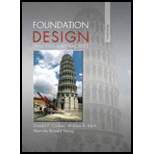
Describe a scenario that would require a very extensive site investigation and laboratory testing program (i.e., one in which a large number of borings and many laboratory and/or in situ tests would be necessary).
The description of the scenario that would require a very extensive site investigation and laboratory testing program.
Explanation of Solution
Introduction:
Site investigation is an integral part of the soil investigation, which consists of determining the engineering properties of the soil present at the site. The first and most important step before the construction is site investigation for the type of soil. The depth of the water table at the site, type of soil, its bearing capacity, and all other important technical aspects are covered under the site investigation.
The laboratory testing is also accompanied with site investigation to extract the details about the engineering properties of the soil which consists of bearing capacity, shear strength, permeability and other properties which are necessary for the construction.
Site investigation and laboratory testing program consists of the extraction of the important engineering properties which governs the type and size of construction. Heavy construction and load-bearing structures require a detailed soil investigation before the start of the construction.
The heavy construction and multi-story building such as hotels, shopping malls, and commercial buildings on soil having low bearing capacity and vulnerable engineering properties require extensive site investigation and laboratory tests. This investigation would give details about the type of soil and the type of construction suited for that soil. The laboratory tests are required for the determination of the bearing capacity of the soil, shear strength, and other engineering properties of the soil.
Conclusion:
Therefore, the heavy and multi-story structures on poor soil strata require extensive site investigation and laboratory testing.
Want to see more full solutions like this?
Chapter 4 Solutions
Foundation Design: Principles and Practices (3rd Edition)
Additional Engineering Textbook Solutions
Elementary Surveying (14th Edition)
Structural Analysis (10th Edition)
Materials for Civil and Construction Engineers (4th Edition)
Elementary Surveying: An Introduction To Geomatics (15th Edition)
Introductory Circuit Analysis (13th Edition)
Fundamentals of Applied Electromagnetics (7th Edition)
- Question 4 Identify the borehole technique that advances drilling into rock formation Hollow stem augers b. Hydraulic push Rotary Wash Solid flight augersarrow_forwardWhat type of opportunities are provided by test pits?arrow_forwardThe soil profile from a geological map of a project site obtained during a Phase 1 investigation as shown Figure 1. For the proposed building: a) Briefly outline the steps in reconnaissance survey and preliminary evaluation of the site. b) Show on a sketch (plan view) your recommendations for the location of borings to be made at the site. c) Give recommendations for the type and depth of borings, the frequency of sampling (if any), and in situ tests (if any), etc. Use handout showed in the class/textbook/Navy Manual/web resources. Please use references when you're recommending something. Elevation-m (ft) 5+00 (15+00) 7+00 (20+00) 9+00 (30+00) 20 m (60 ft) 40 m (120 ft) 10 m (30 ft) Factory Total load -15 kPa (300 psf) 50 m (150 ft) Soft clay Mixture of clay and silt Dense sand and gravels Bedrock (a) Soil profile 40 m (120 ft) Office Total load 12 kPa (250 psf) (b) Plan Figure 1: Project Sitearrow_forward
- Question 1 a) Where the preliminary investigation has indicated the feasibility of the project at the site, more detailed site exploration should be under taken. Depending on the results obtained from the preliminary investigation, additional and deeper boreholes may be sunk; more samples extracted (both disturbed and undisturbed); more sounding field tests undertaken to obtain information which shall be sufficient for final design of foundation of structures. Now with the aid of diagram, evaluate the performance of the following exploration methods employed during site investigation of soils: Standard Penetration Test (SPT) Dynamic Cone Penetration Test Vane Shear Test (VST)arrow_forwardQ2/ Discuss the following 1- The required properties of geological formation to determine its ability to form a good reservoir. 2- Using rotary drilling as an alternative to cable-tool drilling in the petroleum industry. 3- The cause of preferring the top drive system over the rotary table and kelly system. 4- How mud logging can determine the lithology of the drilled formation.arrow_forwardDescribe advantages and disadvantages of test pits.arrow_forward
- is a specialized form of rock excavation that has traditionally been accomplished by drilling and blasting, and more recently through the use of specialized machines. Blasting Core sampling Drilling Tunnelingarrow_forwardTrue or false Enly) A. The cast of soil investigations ranges from 5% to 15% of the total cost of implementing the project. B- The soil exploration program for any project is one of the Common factors that must be agreed upon between the owner, the implementing contractor, and the consultant, and the Consultant. c- The stage of collecting available information may require obtaining different information, such as geological map to delermine the layers of Soil deposits and the depth of the •Yock layer. D-The initial investigation stage begins with making anumber of probes and test pits that are distributed over the area of the project site.arrow_forwardA drag bit or finger bit and a Roller bit are to be used In a geotechnical drilling project, which suitable drill would be preferred in a clay environment and a gravel environment? Explain your choicearrow_forward

 Structural Analysis (10th Edition)Civil EngineeringISBN:9780134610672Author:Russell C. HibbelerPublisher:PEARSON
Structural Analysis (10th Edition)Civil EngineeringISBN:9780134610672Author:Russell C. HibbelerPublisher:PEARSON Principles of Foundation Engineering (MindTap Cou...Civil EngineeringISBN:9781337705028Author:Braja M. Das, Nagaratnam SivakuganPublisher:Cengage Learning
Principles of Foundation Engineering (MindTap Cou...Civil EngineeringISBN:9781337705028Author:Braja M. Das, Nagaratnam SivakuganPublisher:Cengage Learning Fundamentals of Structural AnalysisCivil EngineeringISBN:9780073398006Author:Kenneth M. Leet Emeritus, Chia-Ming Uang, Joel LanningPublisher:McGraw-Hill Education
Fundamentals of Structural AnalysisCivil EngineeringISBN:9780073398006Author:Kenneth M. Leet Emeritus, Chia-Ming Uang, Joel LanningPublisher:McGraw-Hill Education
 Traffic and Highway EngineeringCivil EngineeringISBN:9781305156241Author:Garber, Nicholas J.Publisher:Cengage Learning
Traffic and Highway EngineeringCivil EngineeringISBN:9781305156241Author:Garber, Nicholas J.Publisher:Cengage Learning





